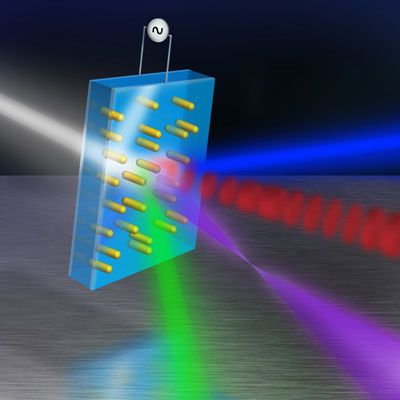| Mar 04, 2019 | |
Plasmonic pixels become dynamic |
|
| (Nanowerk Spotlight) Plasmonic metamaterials are man-made media that acquire unusual optical properties due to nanostructuring. They operate by harnessing properties of resonant surface plasmons (which are collective oscillations of free electrons on the surface of metallic nanostructures). | |
| For more than twenty years, researchers have designed a variety of optical metamaterial-based devices, from those hiding objects for certain colors of light to those sensitive to tiny concentrations of substances. Many of these demonstrations so far present structures that are static in time. In other words, once they are fabricated, their properties are fixed. | |
| "These technologies become much more powerful if they are able to react to external stimuli—such as electric fields—to reconfigure themselves to offer a different set of properties," Jake Fontana, Ph.D., a research physicist at the U.S. Naval Research Laboratory in Washington, DC, tells Nanowerk. "This motivated us to build upon established work in plasmonic color generation to craft plasmonic devices that could be dynamically tuned." | |
| Reporting their work in ACS Nano ("Dynamic Plasmonic Pixels"), Fontana and his collaborators from the United States Naval Research Laboratory and the Air Force Research Laboratory, demonstrate a display pixel that can switch on and off at least 1000 times faster than pixels that use conventional liquid crystal materials. | |
 |
|
| Schematic rendering of the plasmonic pixel structure. (Image: Jake Fontana and Robert Gates) | |
| "We show that plasmonic gold nanorods – which interact very strongly with light – can be aligned using electric fields, and we use this alignment to control the amount of light that can pass through the pixel," explains Fontana. "By engineering the dimensions and material structure of the nanorods, we design pixels that work with different colors of light, both visible and infrared." | |
| The researchers take advantage of two key properties of metal nanorods in order to achieve functional pixels: First, the nanorods couple strongly to the external electric fields, enabling alignment of individual nanorods without the need for near neighbor interactions, as required for liquid crystal materials. Second, the absence of the near neighbor interactions enables the nanorods to respond very quickly to the application and removal of the electric fields. | |
| By combining these two effects, it becomes possible to use an electric field to rotate the nanorods within a pixel to rapidly modulate its optical properties. | |
| In the paper, the team details how the attributes of the nanorods can be engineered to optimize the pixel's operation. | |
| They illustrate, first, by shortening or lengthening the nanorod dimensions, and second, by growing a thin silver shell over the gold nanorod core, that the nanorods can be tailored to match desired light wavelengths across the visible and infrared spectra. | |
| They characterize the performance of the plasmonic pixels through chromaticity and luminance metrics, and they showcase the spatial, spectral, and temporal control of light by fabricating a seven-segment numerical indicator. | |
| The team points out that the fast switching time of their plasmonic nanorod pixels could significantly reduce motion blur and other temporal artifacts in displays in comparison to conventional LCDs. | |
| In addition to the visible light display applications, they envision the dynamic plasmonic nanorod pixel as a generic spatial light modulation platform for arbitrarily controlling the phase, amplitude, and polarization of light on a fast time scale. This may enable integration with optical information processing and communications technologies. | |
| "Our approach could enable technologies that have been challenging to implement with traditional liquid crystal materials, which have limited switching speeds," says Fontana. "One example is field-sequential color displays, where the red, green, and blue components that make up a color image are displayed in rapid succession in time—so quickly that the eye perceives them as a single full-color image." | |
| "Presenting the color-component images rapidly enough requires a material with a fast response time, such as the plasmonic nanorods in our study," he adds. "This contrasts with traditional LCDs that use a white light illuminant with individual color subpixels that must be patterned across the display. By eliminating the need for color subpixels, a field-sequential color display can pack more pixels per area, improving display resolution." | |
| One important step of the team's ongoing investigations will be the integration of the plasmonic nanorod materials into arrays with larger quantities of pixels while scaling down the size of individual pixels. | |
 By
Michael
Berger
– Michael is author of three books by the Royal Society of Chemistry:
Nano-Society: Pushing the Boundaries of Technology,
Nanotechnology: The Future is Tiny, and
Nanoengineering: The Skills and Tools Making Technology Invisible
Copyright ©
Nanowerk LLC
By
Michael
Berger
– Michael is author of three books by the Royal Society of Chemistry:
Nano-Society: Pushing the Boundaries of Technology,
Nanotechnology: The Future is Tiny, and
Nanoengineering: The Skills and Tools Making Technology Invisible
Copyright ©
Nanowerk LLC
|
|
|
Become a Spotlight guest author! Join our large and growing group of guest contributors. Have you just published a scientific paper or have other exciting developments to share with the nanotechnology community? Here is how to publish on nanowerk.com. |
|
